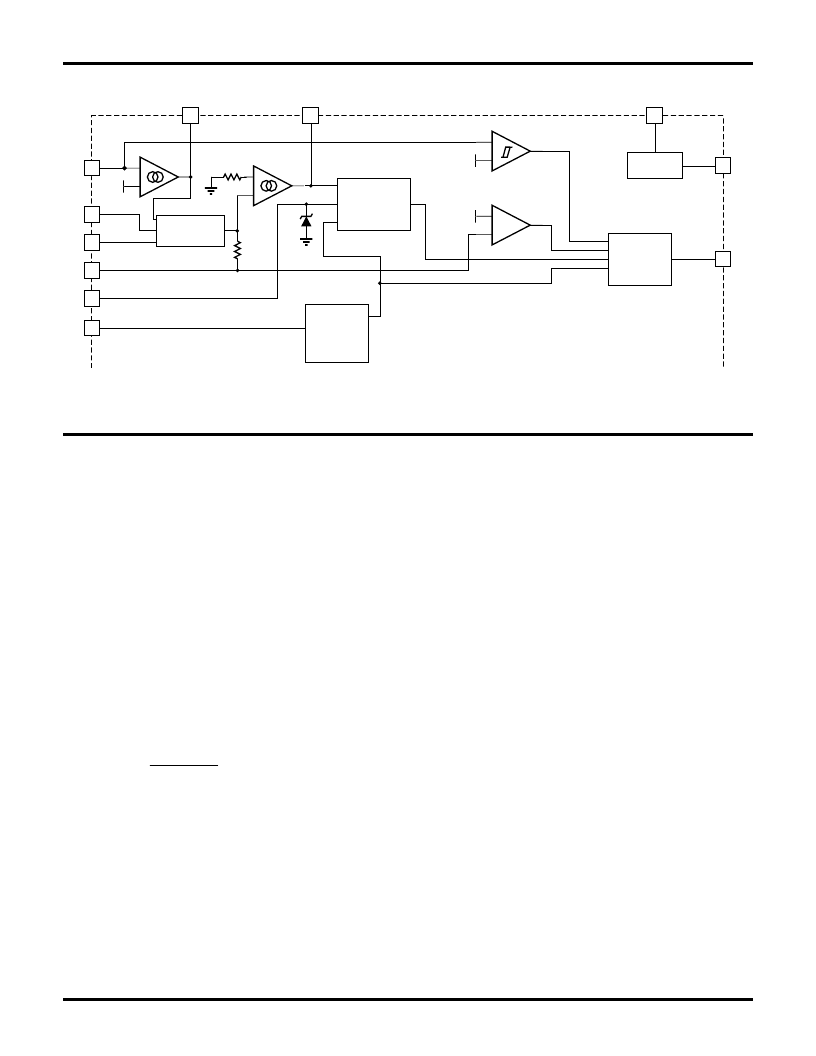- 您現(xiàn)在的位置:買賣IC網(wǎng) > PDF目錄377970 > ML4801IS (FAIRCHILD SEMICONDUCTOR CORP) Variable Feedforward PFC/PWM Controller Combo PDF資料下載
參數(shù)資料
| 型號: | ML4801IS |
| 廠商: | FAIRCHILD SEMICONDUCTOR CORP |
| 元件分類: | 穩(wěn)壓器 |
| 英文描述: | Variable Feedforward PFC/PWM Controller Combo |
| 中文描述: | 0.5 A POWER FACTOR CONTROLLER WITH POST REGULATOR, PDSO16 |
| 封裝: | PLASTIC, SOIC-16 |
| 文件頁數(shù): | 7/14頁 |
| 文件大小: | 160K |
| 代理商: | ML4801IS |

ML4801
REV. 1.1 3/9/2001
7
inversely proportional to V
RMS
2 (except at unusually
low values of V
RMS
where special gain contouring
takes over to limit power dissipation of the circuit
components under heavy brownout conditions). The
relationship between V
RMS
and gain is designated as K.
3) The output of the voltage error amplifier, VEAO. The
gain modulator responds linearly to variations in this
voltage.
The output of the gain modulator is a current signal, in the
form of a full wave rectified sinusoid at twice the line
frequency. This current is applied to the virtual-ground
(negative) input of the current error amplifier. In this way
the gain modulator forms the reference for the current
error loop, and ultimately controls the instantaneous
current draw of the PFC from the power line. The general
form for the output of the gain modulator is:
given by:
(1)
where K is in units of V
-1
.
Note that the output current of the gain modulator is
limited to
500
μ
A.
Current Error Amplifier
The current error amplifier’s output controls the PFC duty
cycle to keep the current through the boost inductor a
linear function of the line voltage. At the inverting input
to the current error amplifier, the output current of the
gain modulator is summed with a current which results
from a negative voltage being impressed upon the I
SENSE
pin (current into I
SENSE
V
SENSE
/1.6k
)
. The negative
voltage on I
SENSE
represents the sum of all currents
flowing in the PFC circuit, and is typically derived from a
current sense resistor in series with the negative terminal
of the input bridge rectifier. In higher power applications,
two current transformers are sometimes used, one to
monitor the I
D
of the boost MOSFET(s) and one to monitor
the I
F
of the boost diode. As stated above, the inverting
input of the current error amplifier is a virtual ground.
Given this fact, and the arrangement of the duty cycle
modulator polarities internal to the PFC, an increase in
positive current from the gain modulator will cause the
output stage to increase its duty cycle until the voltage on
I
SENSE
is adequately negative to cancel this increased
current. Similarly, if the gain modulator’s output
decreases, the output duty cycle will decrease to achieve
a less negative voltage on the I
SENSE
pin.
Cycle-By-Cycle Current Limiter
The I
SENSE
pin, as well as being a part of the current
feedback loop, is a direct input to the cycle-by-cycle
current limiter for the PFC section. Should the input
voltage at this pin ever be more negative than -1V, the
output of the PFC will be disabled until the protection
flip-flop is reset by the clock pulse at the start of the next
PFC power cycle.
FUNCTIONAL DESCRIPTION
(Continued)
15
VEAO
IEAO
VFB
IAC
VRMS
ISENSE
RAMP 1
OSCILLATOR
OVP
+
PFC ILIMIT
+
VREF
POWER FACTOR CORRECTOR
2.5V
-
-
+
16
2
4
3
7.5V
REFERENCE
14
VCC
13
VEA
8
+
–
IEA
1
-
PFC OUT
12
2.75V
-1V
RTCT
7
GAIN
MODULATOR
÷
2
1.6k
1.6k
8V
PFC
OUTPUT
DRIVER
PFC
CONTROLLER
DUTY CYCLE
LIMIT
Figure 1. PFC Section Block Diagram
I
I
VEAO
2
V
V
GAINMOD
AC
RMS
1
More exactly, the output current of the gain modulator is
I
K
VEAO
V
I
GAINMOD
AC
=
×
×
(
.
)
0625
相關(guān)PDF資料 |
PDF描述 |
|---|---|
| ML4801 | Variable Feedforward PFC/PWM Controller Combo(前饋可變PFC/PWM控制器組合芯片) |
| ML4802CP | PFC/PWM Controller Combo with Green Mode |
| ML4802CS | PFC/PWM Controller Combo with Green Mode |
| ML4802IP | PFC/PWM Controller Combo with Green Mode |
| ML4802IS | PFC/PWM Controller Combo with Green Mode |
相關(guān)代理商/技術(shù)參數(shù) |
參數(shù)描述 |
|---|---|
| ML4801ISX | 功能描述:功率因數(shù)校正 IC SOIC-16 RoHS:否 制造商:Fairchild Semiconductor 開關(guān)頻率:300 KHz 最大功率耗散: 最大工作溫度:+ 125 C 安裝風(fēng)格:SMD/SMT 封裝 / 箱體:SOIC-8 封裝:Reel |
| ML4802 | 制造商:MICRO-LINEAR 制造商全稱:MICRO-LINEAR 功能描述:PFC/PWM Controller Combo with Green Mode |
| ML4802CP | 功能描述:功率因數(shù)校正 IC DIP-16 RoHS:否 制造商:Fairchild Semiconductor 開關(guān)頻率:300 KHz 最大功率耗散: 最大工作溫度:+ 125 C 安裝風(fēng)格:SMD/SMT 封裝 / 箱體:SOIC-8 封裝:Reel |
| ML4802CS | 功能描述:功率因數(shù)校正 IC SOIC-16 RoHS:否 制造商:Fairchild Semiconductor 開關(guān)頻率:300 KHz 最大功率耗散: 最大工作溫度:+ 125 C 安裝風(fēng)格:SMD/SMT 封裝 / 箱體:SOIC-8 封裝:Reel |
| ML4802CSX | 功能描述:功率因數(shù)校正 IC SOIC-16 RoHS:否 制造商:Fairchild Semiconductor 開關(guān)頻率:300 KHz 最大功率耗散: 最大工作溫度:+ 125 C 安裝風(fēng)格:SMD/SMT 封裝 / 箱體:SOIC-8 封裝:Reel |
發(fā)布緊急采購,3分鐘左右您將得到回復(fù)。